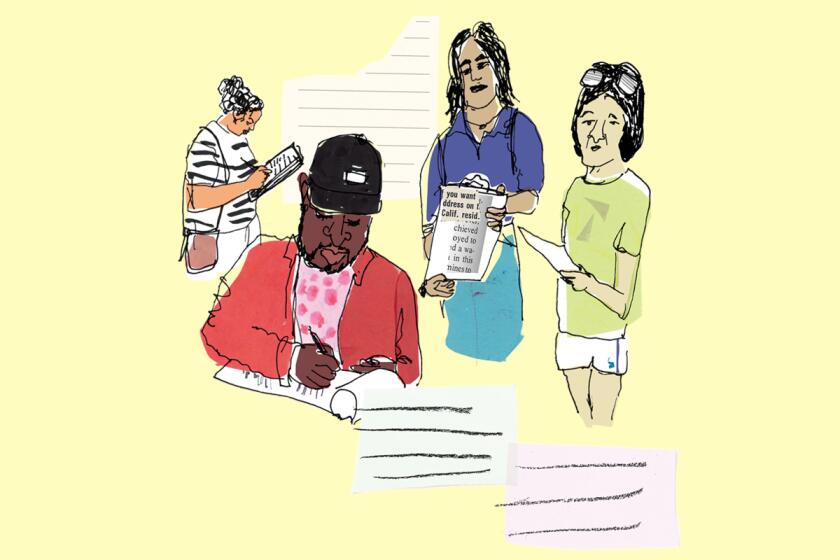‘Woefully inadequate’: Why it’s so hard to find a shelter bed in L.A.

- Share via
Poor and unreliable data collection by the Los Angeles Homeless Services Authority makes it “nearly impossible” for unhoused people and the city to know how many interim beds are available and how many are being used at any given time, according to a new city audit.
Despite having a software-based reservation system for shelter bed availability, LAHSA’s system is so unreliable that the agency monitors bed availability using phone calls and daily emails, the audit found.
The homeless services agency also failed to follow up with interim housing providers on their point-in-time sheltered homeless count data, despite indications of data quality issues. Additionally, many shelters recently reported low bed use rates, which may suggest that the number of unhoused people in shelters is being undercounted and that available beds are not being used.
The new audit also found that LAHSA’s Find-a-Shelter app had inaccurate data and did not attract large participation by providers, which limited its function.
You can help someone get on the path to housing — and make your voice heard on issues of housing and homelessness. Learn how with Shape Your L.A.
At a news conference Wednesday, Sergio Perez, chief of accountability and oversight with the city controller’s office, said the city and its homeless community need a system as reliable as ride-hailing apps that enable people to see available vehicles in real time and where they are.
“That’s what we need to meet the ongoing crisis on our streets today, to meet the real human need of our unhoused neighbors,” Perez said. “It is what we lack.”
Perez said the data system deficiencies raise concerns about L.A.’s attempts to address the homelessness crisis with urgency and calls into question the validity of the city’s efforts not to criminalize poverty.
“If we can’t track interim shelter beds in a timely manner ... then we run the risk, on a day-to-day basis, of violating the Constitution, which prohibits governments like the city of Los Angeles from punishing those who live on our streets when they have no other option. It could be that this is happening in Los Angeles as we speak,” he said.
City Controller Kenneth Mejia said that LAHSA’s dysfunctional system “is not only insufficient for addressing the wide problem of L.A.’s homelessness emergency, but in fact it proved to be fully deficient last winter, when we had severe winter weather.”
According to the report, the homelessness agency contracted with 211 L.A. last winter to respond to requests through the winter shelter hotline and provide referrals to shelters. When 211 staff realized that LAHSA’s bed reservation system was inaccurate, telephone operators were forced to call shelters to verify bed occupancy before making referrals. The process increased wait times for callers and for 211 L.A. to respond to them.
Call-line staff told auditors that they received more than 160,000 shelter-related calls from people for the winter shelter program, but were only able to answer just over 50%.
In a statement released with the report, Mejia said it is crucial that the city maximize use of its “extremely limited amount of interim housing beds” and that providers know when beds are available.
In the audit, Mejia touted Mayor Karen Bass’ move last year to declare the homelessness crisis a state of emergency, but pointed to the inadequacy of some resources available to properly address it: Only 16,100 interim housing beds are available for the estimated 46,260 people in the city experiencing sheltered or unsheltered homelessness, according to LAHSA’s 2023 homeless count.
“[T]he woefully inadequate amount of both interim and permanent housing resources, as well as the antiquated and inefficient methods of data collection and housing referral processes, significantly inhibit efforts by the city to respond to the crisis with the urgency that it requires,” he said.
In a statement to The Times, LAHSA said the audit comes as the agency is working to enhance its data practices and improve the accuracy of its bed availability information.
The new bed-availability system in the works will include detailed tracking of beds, units, sites and buildings; current occupancy rates; real-time unit and bed availability; and information for service providers about all the programs in a building, among other things. The system will be fully implemented by Dec. 31, 2024.
LAHSA added that it is developing a new client portal that will improve communication tools. People seeking services will be able to see a list of all shelters and access centers; view upcoming appointments; direct-message case managers and get alerts to help them find shelter during emergencies or severe weather events.
Get the lowdown on L.A. politics
Sign up for our L.A. City Hall newsletter to get weekly insights, scoops and analysis.
You may occasionally receive promotional content from the Los Angeles Times.
“Data collection and dissemination are at the core of LAHSA’s purpose, and we are making significant improvements so we can offer the information that maximizes our interim housing system and move into permanent housing faster,” the agency said.
The city controller’s office recommended that LAHSA, in collaboration with the city, redesign a shelter bed availability system that makes it easier to facilitate referrals to its shelters. It also suggested that it craft and execute a plan to “monitor, evaluate, and enforce” requirements for shelter program operators to report bed attendance and availability data completely, accurately and in a timely manner.
Lastly, the office advised the agency to require operators participating in the annual homeless count that report bed use rates lower than 65% or more than 105% to accurately count the number of unhoused people in their shelter and explain bed use rates.
Along with the audit, the city controller’s office also launched an interim housing bed availability map. Officials said they hope it serves as an example for LAHSA if it follows their recommendations.
More to Read
Sign up for Essential California
The most important California stories and recommendations in your inbox every morning.
You may occasionally receive promotional content from the Los Angeles Times.












